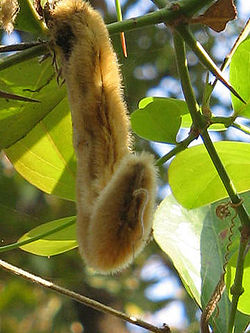Gallery
 |  |  |
Itching powder is a powder or powder-like substance that induces itching when applied onto human skin. This is usually done as a practical joke or prank to an unsuspecting victim.
The cause of the irritation can be mechanical, such as products containing ground rose hips. [1] [2] Another common ingredient is Mucuna pruriens , [3] a type of legume that produces seedpods coated with thousands of detachable spicules (needle-like hairs). The spicules contain an enzyme, mucunain, that causes severe itching, and they have been sold commercially as itching powder. [4] Mucuna pruriens has been used to test the efficacy of anti-itch drugs. [3]
The term "itching powder" is colloquial; there is no one specific source of the powder. For the safety of the maker and of the victim, gloves, dust masks, and glasses are worn, as itching powder is a mouth- and eye-irritant, and caution is strongly encouraged whenever handling the processed powder. Rose hips contain prickly hairs that are used as the active ingredient, [5] whereas the body (rather than the wing) of the samara of the bigleaf maple is covered with spiny hairs that cause skin irritation and are used to make itching powder. [6] [7] [8]
Itching powder was created from Mucuna pruriens in the early-19th century as a cure for lost feeling in the epidermis. When a person would lose feeling on their skin in conditions such as paralysis, the powder (mixed with lard to form an ointment) was used as a local stimulant believed to treat the condition. [9] [10]
 |  |  |